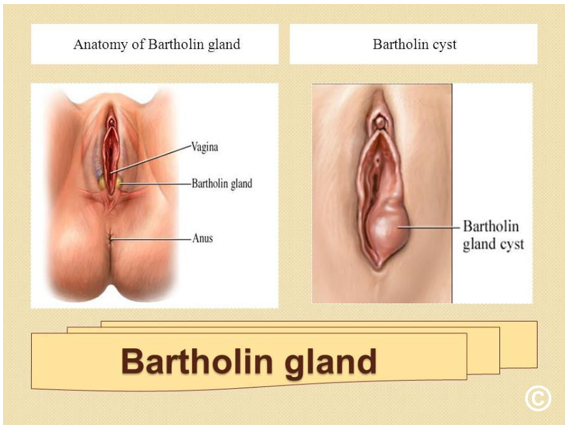- Reference Number: HEY1442/2024
- Departments: Gynaecology
- Last Updated: 31 January 2024
Introduction
This leaflet aims to give you some general information about Bartholin’s cysts and help to answer any questions you may have. It is intended only as a guide and there will be an opportunity for you to talk to your nurse and doctor about your care and treatment.
What is a Bartholin’s cyst?
A Bartholin’s cyst, also called a Bartholin’s duct cyst, is a small growth just inside the opening of a woman’s vagina. Cysts are small fluid-filled sacs that are usually harmless.

Bartholin’s glands
The Bartholin’s glands are a pair of pea-sized glands that are found just behind and either side of the labia minora (the inner pair of lips surrounding the entrance to the vagina). The glands are not usually noticeable because they are rarely larger than 1 cm (centimeters) (0.4 inches) across.
The Bartholin’s glands secrete fluid that acts as a lubricant during sexual intercourse. The fluid travels down tiny ducts (tubes) that are about 2 cm (centimeters) (0.8 inches) long into the vagina. If the ducts become blocked, they will fill with fluid and expand. This then becomes a cyst.
How common is a Bartholin’s cyst?
According to estimates, around 2% (1 in 50) of women will experience a Bartholin’s cyst at some point. The condition usually affects sexually active women between the ages of 20 and 30. The Bartholin’s glands do not start functioning until puberty, so Bartholin’s cysts do not usually affect children.
During the menopause, the Bartholin’s glands usually shrink. Therefore, any swellings in the vulva (the external sexual organs) of women who have started the menopause are unlikely to be Bartholin’s cysts.
Outlook
A Bartholin’s cyst can remain small and painless and may not cause any symptoms. However, it is possible for the cyst to become infected, which can cause an abscess (a painful collection of pus) in the Bartholin’s gland.
If the cyst becomes large or painful, a number of treatments are available to drain and remove the cyst. Most treatments involve a minor surgical procedure under local anaesthetic (painkilling medication) or in some cases General Anaesthetic, which takes around 20 minutes to complete.
Following surgery to drain and remove a cyst, it will take around 2 weeks for you to fully recover.
Depending on which procedure is used, the cyst or abscess can re-occur in up to 38% of women.
What are the symptoms of a Bartholin’s cyst?
Most Bartholin’s cysts do not cause any symptoms. However, you may feel a soft, painless lump in your labia (the two pairs of lips that surround the entrance to your vagina).
You may not know that you have a cyst until it is found by a healthcare professional during a routine cervical screening test (smear test) or another gynaecological examination.
If the cyst grows very large, it can become uncomfortable and noticeable. You may experience pain in your vulva (external sexual organs) at certain times such as:
- during sexual intercourse;
- when walking; or
- when sitting down.
Sometimes, the cyst can affect the labia majora (the outer pair of lips around the opening of the vagina). One side may look swollen or bigger than usual.
What causes a Bartholin’s cyst?
A Bartholin’s cyst is caused by an obstruction that blocks the duct (tube) leading from the Bartholin’s gland into the vagina. This leads to a build-up of fluid, which can turn into a cyst.
Several different types of bacteria can cause an infection that blocks the duct. Some types of bacteria can be passed on through sexual contact while others are found in the environment. Bacteria that may cause a Bartholin’s cyst include:
- Gonococcus: Usually responsible for gonorrhoea (a sexually transmitted infection) and may be responsible for around a third of Bartholin’s cysts.
- Chlamydia trachomatis: Usually responsible for chlamydia (another sexually transmitted infection).
- Escherichia coli: Often responsible for food poisoning.
- Streptococcus pneumoniae: Responsible for pneumococcal infections, such as infections of the inner ear or sinuses.
- Haemophilus influenza: Responsible for a number of infections such as epiglottitis, an infection of the epiglottis, an infection of the epiglottis (the flap of tissue at the back of your throat).
How is it treated?
No treatment is needed if the Bartholin’s cyst is small and is not causing any symptoms. However, women who have started the menopause are always advised to have a biopsy taken, as this can also be a symptom of vulval cancer.
If the cyst is causing some pain, your GP may advise:
- having warm baths;
- using a warm compress (cloths or cotton wool warmed with hot water) held against the area; or
- using pain relief, such as paracetamol or ibuprofen. Always read the manufacturer’s instructions when using over the counter medication.
Children under 16 years of age should not be given aspirin.
If the cyst becomes infected and an abscess (a painful collection of pus), you may be prescribed antibiotics to clear the infection; however, once treated your GP may still recommend having the cyst drained, particularly if the abscess is large.
Surgical management of Batholin’s cyst
Making an incision (cut) in the cyst and draining the fluid out is not always recommended because the cyst will often return; however, there are a number of surgical options for treating large, painful cysts and abscesses, these include:
Incision and drainage
Incision and drainage of a Bartholin’s cyst usually takes 5 to 10 minutes to perform. A local anaesthetic is given and then a small incision (cut) is made into the cyst or abscess to allow the fluid or pus to drain out.
A swab will be taken to test for the bacteria, which caused the infection.
Marsupialisation
If a cyst or abscess keeps coming back, a surgical procedure known as marsupialisation may be used. Marsupialisation takes about 10 to 15 minutes and is usually performed as a day case procedure, so you will not have to stay in hospital overnight.
This procedure is usually carried out under general anaesthetic, although local anaesthetic can be used instead.
An incision (cut) is made into the cyst and the fluid is drained out, the edges of the skin are then stitched to create a small pouch, which allows any further fluid to drain.
When the procedure is complete, the treated area may be loosely packed with gauze to soak up fluid from the wound and stop any bleeding. This will be removed before you go home. Bartholin’s Cyst treatment is routinely managed as a day case surgery meaning that it should not involve an overnight stay in hospital.
Although complications after marsupialisation are rare, they can include:
- Infection.
- The abscess recurring.
- Bleeding from the wound site.
- Pain – Using pain relief, such as paracetamol or ibuprofen should be effective following marsupialisation. Always read the manufacturer’s instructions when using over the counter medication.
Children under 16 years of age should not be given aspirin.
After marsupialisation, you will be advised to take things easy for a few days. You should avoid having sexual intercourse until the wound has completely healed, which usually takes about 2 weeks.
If you are taking regular anticoaguation medication such as Warfarin or Apixaban you should make the medical staff aware as you may be required to stop this medication prior to having your surgical procedure.
Re-occurrence
The rate of reoccurrence of a cyst or abscess after one of these procedures is, on average, around 20% (1 in 5). One study of needle aspiration found the reoccurrence rate to be 38% and one study of marsupialisation found no reoccurrences.
Complications of a Bartholin’s cyst
Although rare, Bartholin’s cyst can sometimes be a symptom of vulval cancer. This is a type of cancer that affects the vulva (a woman’s external sexual organs). Occasionally, vulval cancer can affect the Bartholin’s glands (the two glands either side of the vagina) and a growth or cyst may appear.
Vulval cancer is a relatively rare form of cancer, with about 1,000 cases diagnosed in the UK each year. There are several different types of vulval cancer and, depending on the stage of the condition when it is diagnosed, the outlook can be good. Visit your GP immediately if you notice any changes to your vagina, such as pain or itching.
Preventing a Bartholin’s cyst
A number of bacteria can cause a Bartholin’s cyst (see Causes above) and you may not be able to avoid being exposed to all of them. Some of these bacteria are also responsible for sexually transmitted infections (STIs), such as gonorrhoea and chlamydia. You can protect yourself against these infections by practising safer sex. If you are sexually active, having safe sex gives you and your partner the best protection against STIs.
Should you require further advice on the issues contained in this leaflet, please do not hesitate to contact the Gynaecology Department as detailed below:
- Cedar Gynaecology Ward (24 hours, 7 days a week) – tel: 01482 604387
- Emergency Gynaecology Unit (EGU) (Monday to Friday, from 08:30 am to 17:45 pm) – tel: 01482 608767
- Gynaecology Outpatient Department (Monday to Friday, from 08:00 am to 17:45 pm) – tel: 01482 607893
Other useful contact numbers and website addresses:
NHS Direct – 111
NHS website – Bartholin’s cyst – NHS (www.nhs.uk)
Patient UK – Bartholin’s Cyst: Symptoms, Causes, and Treatment (patient.info)

